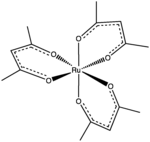Ruthenium(III) acetylacetonate

| |

| |
| Names | |
|---|---|
| IUPAC name
Tris(acetylacetonato)ruthenium(III)
| |
| Other names
Ru(acac)3; Ruthenium(III) 2,4-Pentanedionate; Ruthenium(III) acetylacetonato, 2,4-pentanedione ruthenium(III)
| |
| Identifiers | |
3D model (
JSmol ) |
|
ECHA InfoCard
|
100.034.705 |
| EC Number |
|
PubChem CID
|
|
CompTox Dashboard (EPA)
|
|
| |
| |
| Properties | |
| (C5H7O2)3Ru | |
| Molar mass | 398.39 g/mol |
| Appearance | Dark violet solid |
| Density | 1.54 g/cm3[1] |
| Melting point | 260 °C (500 °F; 533 K) |
| insoluble in water | |
| Solubility | soluble in most organic solvents |
| Hazards[2] | |
| GHS labelling: | |

| |
| Warning | |
| H302, H315, H319, H335, H413 | |
Except where otherwise noted, data are given for materials in their standard state (at 25 °C [77 °F], 100 kPa).
| |
Ruthenium(III) acetylacetonate is a
Preparation
In 1914 tris(acetylacetonato)ruthenium(III) was first prepared by the reaction of ruthenium(III) chloride and acetylacetone in the presence of potassium bicarbonate.[4] Since then, alternative synthetic routes have been examined, but the original procedure remains useful with minor variations:[5]
- RuCl3•3H2O + MeCOCH2COMe → Ru(acac)3 + 3 HCl + 3 H2O
Structure and properties
This compound has idealized D3 symmetry. Six oxygen atoms surround the central ruthenium atom in an octahedral arrangement. The average Ru-O bond length in Ru(acac)3 is 2.00 Å.
Reduction of Ru(acac)3 in the presence of
- 2 Ru(acac)3 + 4 alkene + Zn → 2 Ru(acac)2(alkene)2 + Zn(acac)2
The resulting compounds are rare examples of metal-alkene complexes that reversibly sustain oxidation:
- Ru(acac)2(alkene)2 ⇌ [Ru(acac)2(alkene)2]+ + e−
The complex has been resolved into individual enantiomers by separation of its adduct with dibenzoyltartaric acid.[9]
References
- ^ .
- ^ "C&L Inventory". echa.europa.eu.
- ISBN 0-12-488150-5.
- ^ Barbieri, G. A. (1914). "Systematic chemical investigations: ruthenium, rhodium, palladium". Atti Accad, Lincei. 23 (1): 334–40.
- ISSN 0376-4710.
- .
- .
- .
- .
